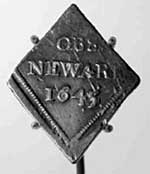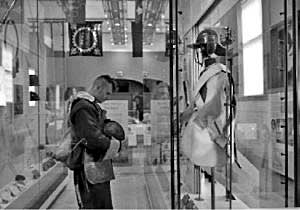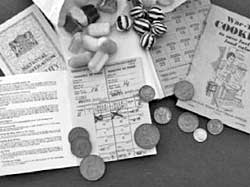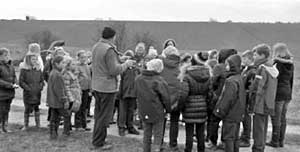News for Summer 2015
ROMAN SOUTHWELL COMMUNITY ARCHAEOLOGY PROJECT
The Roman Southwell Community Archaeology project ('Researching Roman Southwell') was set up in 2014 to investigate the Roman settlement of Southwell, Nottinghamshire and the surrounding landscape. The project is professionally led by Matt Beresford of MBArchaeology. Phase One ran throughout 2014 and looked at documentary and archival sources, old maps, Historic Environment Records and past excavation reports. The results of the first investigations are documented on the project website www.romansouthwell.wordpress.com.
Phase Two of the project involved a very successful fundraising campaign, supported by DigVentures, in order to fund a season of fieldwork in the town of Southwell. Work on the Harvey's Field site (adjacent to the Roman Villa site) can now begin as planned from May 2015 onwards. The project leaders are continuing their fund raising through events, public donations and local business support in order to raise enough money for Phase Three. This will be a landscape approach, and will involve geophysical surveys and fieldwalking in an attempt to shed more light on to the Roman Road (Newark Road) from Southwell through to Kirklington. The provisional start date for this will be October 2015, depending on sufficient funds being raised. Thoroton Society members can sign up to be part of the project by donating towards the project's funding goal:
Auxiliary Package (£10 donation)- you will receive email updates of progress, upcoming events and activities.
Legionary Package (£25 donation) - as above, and you will receive a mention in the acknowledgements section of all reports. In addition, you will receive electronic copies of the reports.
Gladiator Package (£50 donation) - as above. You will also receive a hard copy of the reports and free entry to all our activities and events (including the post-fieldwork parties!).
Caesar Package (£100 donation) - all of the £50 level benefits plus an 'Archaeology Day Experience' (either a Dig-day, Finds Analysis day, Geophysics session or Fieldwalking day, depending on current plans)
Emperor Package (£150 donation) - Premium Package! All of the £50 level benefits, plus a two-day activity plan (choose 2 x Dig-day, Finds Analysis day, Geophysics session or Fieldwalking day, depending on current plans)
John Wilson
CONFERENCE REPORT - SOUTHWELL'S FIRST ARCHAEOLOGY DAY
The 'Researching Roman Southwell' Project team hosted an Archaeology Day at the Minster School in Southwell on Saturday 17th January, with all proceeds from the day going into the project funding campaign. A packed Arts Theatre at the Minster School heard four excellent presentations. The first speaker was Matt Beresford (MBArchaeology). Matt summarised the background to the 'Researching Roman Southwell' project and the current state of knowledge of Roman Southwell. The existence of a large villa is known, but its extent is largely unknown as much of it lies beneath later buildings. The villa is near the Potwell Dyke, which may have been wider in Roman times, and there was possibly an Iron Age shrine on or near the site of the villa. From April onwards, a geophysical survey will be carried out, followed by the digging of test pits from Farthingate to the Potwell Dyke. A full report will be prepared once the field work and the processing of any finds have been completed.
The Project, which raises its own funds, needs £4,200 to carry out the work; £1,200 had already been raised and Matt invited members of the audience to join in supporting the work.
Andy Gaunt (Mercian Archaeological Services) then described the ongoing exploration of King John's Palace at Clipstone and explained the extent of Sherwood Forest in mediaeval times, indicating the features it encompassed, its uses and its importance. A paper on this topic was published by Andy in collaboration with James Wright in Transactions of the Thoroton Society volume 117 (2013).
Rachael Hall (National Trust) gave a fascinating account of the recent discovery of a Late Iron Age/Roman coin hoard in a cave at Dovedale in the Derbyshire Peak District. A climber sheltering from heavy rain in the cave known as Reynard's Kitchen found four coins, three Roman and one Iron Age British. A team of archaeologists from the University of Leicester, the National Trust and the Defence Archaeology Group then explored the cave. They recovered twenty-six coins, including three Roman coins that dated from the Roman republic, well before the invasion of Britain in AD43. Most of the coins were of gold and silver and have been attributed to the Corieltavi tribe. This is somewhat surprising as the tribe was mainly associated with areas further to the east, such as Lincolnshire. The coins will be displayed at Buxton Museum.
Finally, Kevin Winter delivered a detailed, well-illustrated talk on the work that has been undertaken to set up a new National Civil War Centre at Newark.
John Wilson
THE ROMAN LANDSCAPE OF SOUTHWELL: A PRESENTATION BY MATT BERESFORD OF THE ROMAN SOUTHWELL COMMUNITY PROJECT, 19™ MARCH 2015.
Following on from his talk at the first Southwell Archaeology Day in January 2015, Matt Beresford, the director of the Roman Southwell Community Project, delivered a fascinating lecture on the current state of research into the Roman features of Southwell and their relationship with the local topography and other discoveries further afield. Preliminary work involved collating the results of earlier investigations to produce a comprehensive map of Roman (and Iron Age) sites and finds throughout Nottinghamshire and Derbyshire, and beyond. This exercise made it clear from the pattern of roads, forts, villas, waterways and geological structures that the area was of considerable strategic importance. A series of maps and plans illustrated Matt's lecture most effectively.
About ten hill forts have been identified in the Peak District and several in the areas near Bolsover and Southwell, including Dorket Head. It is possible that the Burgage in Southwell may have been the site of an Iron Age/early Roman fort or camp; it lies on a Roman road that runs between Ad Pontem and Osmanthorpe in a NW direction. The fort at Osmanthorpe is the largest in the area and seems to have been constructed on an existing site by the earliest Roman invaders in the 50s BC, long before the Claudian conquest of AD43.
Evidence suggests that the Coritani (or Corieltavi) tribe in Nottinghamshire and the neighbouring Brigantes in Derbyshire may have established a boundary between their territories along a magnesium limestone ridge running diagonally over the two counties. A few Iron Age coins, found mostly in the Newark and Sherwood district, are linked with the Coritani and confirm their presence in the area.
Lower Kirklington Road is of Roman origin and crossed by another Roman road near the Burgage which leads to Southwell's villa. Two coins have been discovered along this road, which runs out to the villa in Thurgarton; but why should coins have been left on the precise line of a road? It is thought possible that they were deliberately embedded in the road as offerings to the gods rather than just lost by accident.
The scanty remains of the villa in Southwell were noted as early as the 18th century but not excavated until the 1950s, when part of the east wing incorporating a bath house with painted wall plaster (a fragment of which can be seen on display in the Minster) and part of the south wing with a mosaic floor were brought to light. The exact extent of this villa is still unknown and may never be confidently established due to the fact that an Anglo-Saxon church with a burial plot was constructed across part of the site and the impossibility of digging under existing buildings. Even a LIDAR (Laser Illuminated Detection And Ranging) survey of the area failed to indicate any traces of the villa; this technique can produce digital elevation models that show details of landscape and the structures upon it with more precision than aerial photography or geophysical surveys, and can be adjusted on a computer to give the lie of the land beneath any buildings or woodland.
The next phase of the Community Project is to sink about 20 test pits in Harvey's Field and a strip on the far side of the Potwell Dyke, which was probably a much wider waterway in Roman times. Previous investigations here have shown the presence of layers of tufa, which is found in flood plains, and potsherds between the layers dating from the Roman period to mediaeval times have been discovered. This therefore would seem to be a fruitful site for further examination.
The campaign to raise funds and support for the Project's work has been very successful, thanks to generous donations and the money raised from events. But more funds will be required for future ventures, and active support from interested individuals. Please refer to the earlier article about the Archaeology Day for information about how to get involved!
Janet Wilson
UK'S NATIONAL CIVIL WAR CENTRE UNVEILED WITH A BANG IN NEWARK

Photograph © National Civil War Centre
The Civil War was Britain's deadliest conflict and one which shaped our modern world.
Now the UK's first ever National Civil War Centre - a flagship project by Newark and Sherwood District Council - has opened in Newark.
The £5.4 million attraction, backed by £3.5m from the Heritage Lottery Fund, is based in Newark's magnificent Grade II* Old Magnus Building, which began life as a Tudor grammar school. It is expected to attract over 60,000 visitors a year.
The opening was marked with a terrific early May Bank Holiday weekend involving over 1,000 re-enactors and camp followers. Newark Castle, the Queen's Sconce and Riverside Park all saw dramatic scenes with cannon fire heard across the town, whilst the Market Place resounded to a mass salvo of musket fire!
The British Civil Wars were fought across England, Scotland, Wales and Ireland from 1638 to 1652. Newark, held by the Royalists, played a major role, undergoing three sieges. The last of these in 1645-46 caused terrible suffering.
Tokens were minted for use as coinage during the Siege of Newark
Historians have gained a unique insight into the town's experience with the discovery of a treasure trove of previously unexamined papers in local archives. They reveal how ordinary people coped with being caught in the cross-fire between cavalier, roundhead and Scottish armies.
Stuart Jennings, from Warwick University, probed this forgotten material.
"By the time I got to the third box of papers I could see that we had something unique here. On individual sheets were accounts, petitions and bills, the kind of things generated by everyday life in 1640s Newark. This kind of material does not normally survive the Civil War, so we are getting a rare glimpse into ordinary lives. We have records of poor relief detailing how money was raised and to whom it was paid during the third siege. There is a petition from a man with seven children whose house was blown up by cannon fire and receipts for food and medicine for plague victims."

Photograph © National Civil War Centre
This insight into the past has been used with state-of-the-art technology and many previously unseen relics to create a unique museum experience. The aim is to tell the story of the man and woman in the street, as well as the fateful decisions of the power-brokers. Newark's story has also inspired another UK first innovation - an augmented reality National Civil War Trail. This £300,000 project tells the story of plague and plot using a specially designed app for smart devices. Featuring lavishly filmed costumed scenes worthy of Hollywood and shot at locations in Newark, visitors are encouraged to explore key Civil War sites across the town's historic landscape.
Newark was hotly disputed during the Civil Wars because it lay at the crossroads of the Great North Road and Fosse Way and also provided a key crossing over the River Trent. Parliamentary forces and their Scottish allies were desperate to oust the Royalist garrison and the last siege saw over 16,000 troops seal off the town. An outbreak of typhus and plague added to Newark's woes as the population swelled to 6,000, creating near starvation conditions. A third of the inhabitants died and one in six buildings were destroyed.
The National Civil War Centre is open from 10am to 5pm daily. Prices -adults £7, children £3 and concessions £6. The town trail app can be downloaded for free on Google Play of itunes App Store. Search for NCWC.
Further information: National Civil War Centre www.nationalcivilwarcentre.com
Richard Darn, National Civil War Centre
NEWS FROM NEWARK AIR MUSEUM

WW2 memorabilia. Photograph © Newark Air Museum
Museum staff and volunteers are currently making plans for Victory Days 2015; a two day event in July (Saturday 25th & Sunday 26th 2015) that will commemorate the 70th Anniversary of VE and VJ Day at the Newark Air Museum.
Our organisers are keen to hear from any veterans of any of the military or civilian forces during World War II, as the museum is keen to invite these veterans along to the event as its special guests. Details of a former service number or membership of an appropriate armed forces veteran's organisation can secure them free entry to the event at the museum's site in eastern Nottinghamshire, close to the border with Lincolnshire.
For the younger visitors the museum is planning to operate a World War II style sweet shop in the Dambusters' Hut, where visiting children will be able to collect their free World War II sweet ration. To collect their ration they will need to bring along some pre-decimal coinage - so parents and grandparents will need to look out for those sixpences, three-penny bits, pennies, half-pennies or even farthings - and make sure that they bring them along. Visitors should not worry too much if they cannot find suitable coinage as the museum will have some available to make sure that everyone gets their ration!
Throughout the two days there will be a host of World War II related activities and entertainment taking place around the site, including alongside its famous Anderson Shelter and Dig for Victory Garden. Visitors will also be able to sample some examples of wartime food delights, such as bread & dripping, spam, corned beef and jam sandwiches.
THE MICHAEL WOOD HISTORY AWARD
In 2013 the well-known historian and television presenter, Michael Wood, gave a lecture in Newark for the Thoroton Society. He had recently been involved in filming at Laxton. After the lecture, he generously donated his speaker fee to the Laxton History Group to be used to promote 'local history as a leisure time activity' in the local community.
The Group decided that there is no better way to promote local history than through young people, some of whom might go on to develop history as a lifetime hobby. The suggestion was made to offer prizes for young people to produce their own personal research completed in their leisure time. There seems to be, however, a sad lack of young folk taking an interest in local history groups. The way forward seemed to be to work through schools, but as anyone involved in education will tell you schools these days are reluctant to be involved in activities which do not encompass the National Curriculum. The last thing we wanted was for the Michael Wood History Award to become yet another school prize as this would defeat the object of personal research completed as a hobby.
After discussion with some of our Nottinghamshire schools we found themes in the History National Curriculum which could certainly include local history elements, and we suggested that the students who chose to participate in the Award should extend their school learning at home in their own time and that the prizes would be awarded to those students who had most enthusiastically undertaken their own research. Michael Wood was made aware of this and he thought it was an excellent idea.
Kneesall School were most enthusiastic and they agreed to pilot the scheme this year as it fitted in with the National Curriculum history element for Years Five and Six, who were working on the theme of Then and Now.' After some initial teaching in school about the history of the village of Laxton, on a cold, grey and windy day in March, Years Five and Six arrived at the Visitor Centre at Laxton. The children were keen to know how the village had changed over time and in the Visitor Centre we were able to examine with them the photographs and the agricultural implements on show. They had some interesting and imaginative ideas on what the implements may have been used for! They particularly enjoyed pretending to use the old plough but they were horrified at the thought of a plough boy ploughing one of the strips in a day.
We then took a very brisk walk to the motte and bailey castle where we were invigorated by the cold winds which came roaring in over the Lincolnshire plains. The children were fascinated by the thought that this was once King John's hunting lodge and they used the clues around them to work out the layout of the castle and surrounding buildings. It was delightful to see how much they had remembered from their lessons in school and how they could apply it to the grassy mounds.

Photograph © Laxton History Group
Off we went again to one of Laxton's Open Fields and there a local farmer spoke to the children about the three field system of agriculture and how it had worked in the past and how it still works today. They were delighted to have "a real farmer" speak to them and they asked intelligent and insightful questions about the system and how it has changed over the years. On the way through the fields we looked at trees and wild flowers and talked about their history in the environment. Finally we walked back through the village and talked about the village today and how it has changed over the years.
It was then up to the children to choose an aspect of local history and to continue their interest in their own time and to produce their own individual projects to be judged by the school for the Award.
We were amazed and delighted at what the children produced. Some chose to study their own localities in the way we had looked at Laxton but the diversity of the projects they had chosen to study was surprising; some chose the history of their own house; some looked at a particular family; one boy studied mining in the area; another looked at the history of the oil industry locally; a girl studied ancient trees in Nottinghamshire. They were enthusiastic and industrious and they involved their parents and grandparents in the studies. One grandmother confessed to me that the whole family had to visit all of the sites mentioned in her granddaughter's project. All of the parents we spoke to said how much the children had enjoyed and become involved with the project.
At the end of term the school held a wonderful open afternoon for the parents, grandparents and members of the Laxton History Group so that they could see the results of the children's efforts. We also displayed the children's work at the Local History Fair in Mansfield in May.
What it brought home to those of us who were involved in this pilot scheme is how history came alive for those children because it related to them, their families and their localities. It brought whole families together studying their own history and it involved the school in the community too. The awarding of the prizes became only secondary to the involvement of the young people in local history. Michael Wood can be proud of the hares he set chasing and we would thoroughly recommend other history groups to think of ways to involve young people and to work with their local schools if possible.
Joan Cottee, Co-Chairman of Laxton History Group.